DIY box tree caterpillar killer
Protect your box trees hedges from destruction with an effective homemade box tree caterpillar killer! Take quick action to eliminate these pests safely, without resorting to harmful insecticides. Learn how a simple, natural remedy from your pantry can help you tackle box plants caterpillars with ease.
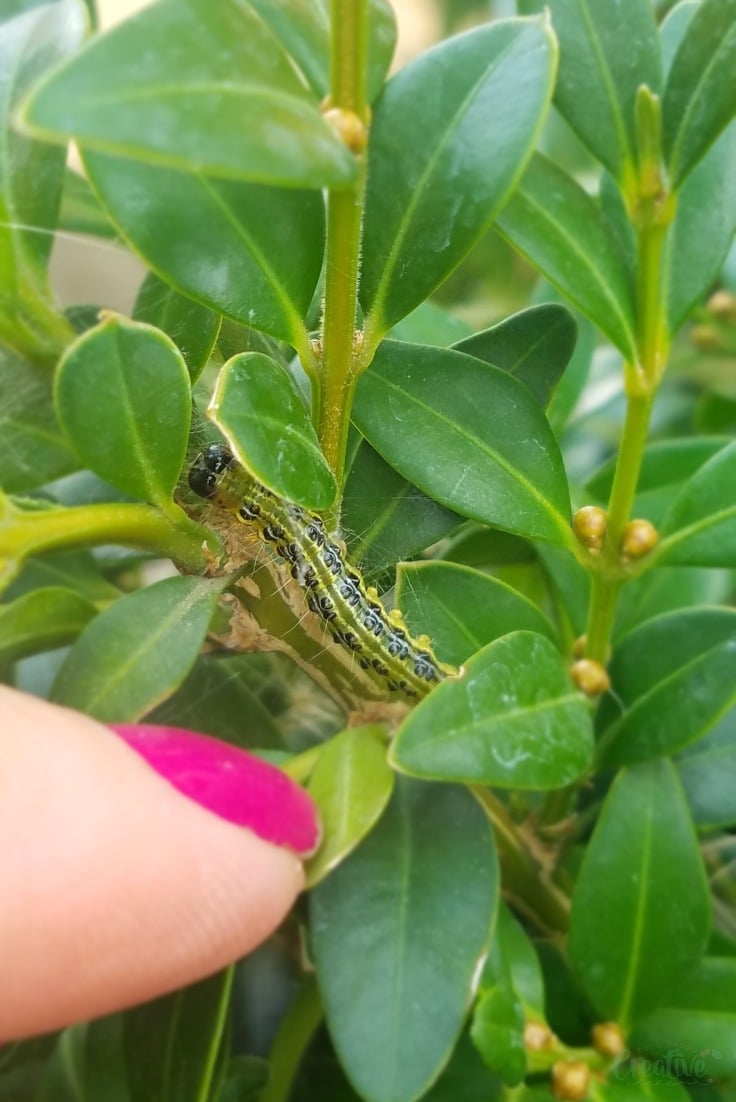
You guys! I just had one of the most terrifying experiences since starting my garden. Box tree caterpillars swarmed and nearly destroyed my box trees in under 5 days! Thankfully, my homemade caterpillar killer saved them, but the thought of those insects still gives me shivers!
To be fair, it’s not just a box caterpillar killer—it’s a universal pest treatment I use in my garden. I first tried this homemade solution as an aphid killer on my roses and haven’t had aphid problems since. This time, since I didn’t have any other pesticide on hand, I used it as a box tree caterpillar killer out of sheer desperation—I panicked and didn’t know what else to do!
I was about to leave for a 5-day vacation when I spotted some disgusting creatures with black heads and green stripey bodies in my buxus: slimy, hairy caterpillars! Even worse, there was some white webbing, countless box tree moth eggs, and substantial damage to my beautiful box hedge. My heart sank—I had no idea these creatures could even exist, let alone destroy plants so quickly. It felt like an impossible battle! Especially since they seem to be active for a very long period of time, from end of June – beginning of July to end of September – beginning of October!
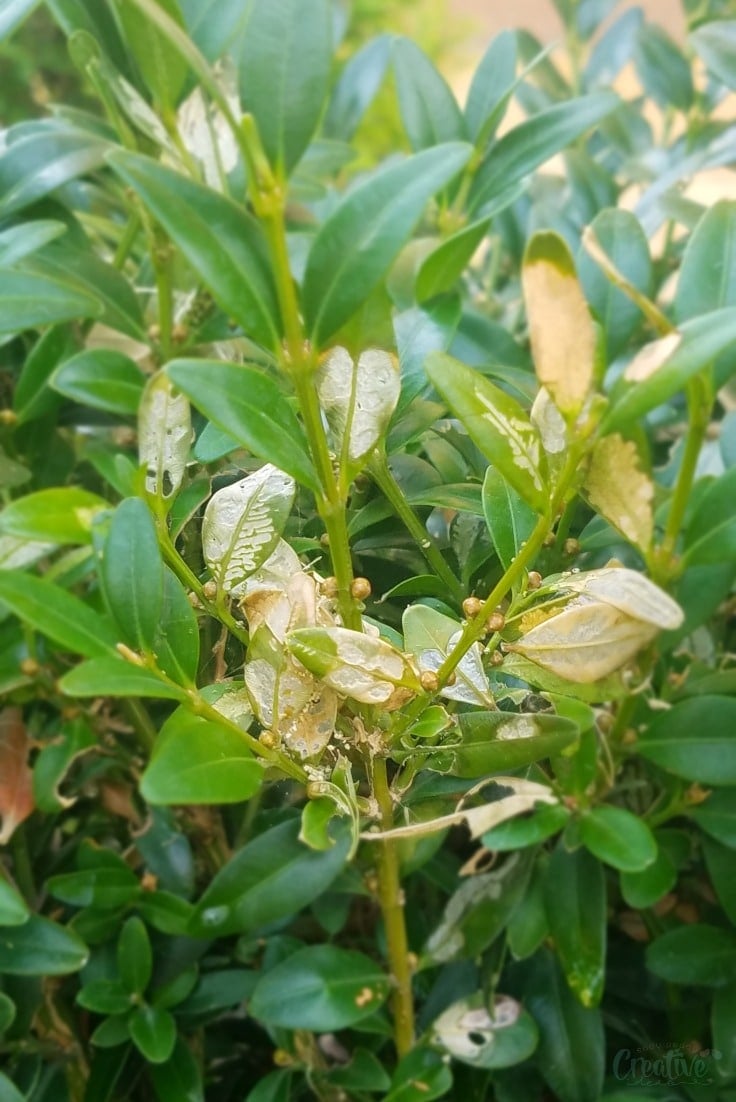
I had to act fast with my vacation just days away! That evening, I used my aphid killer on the box tree caterpillars. It worked—within days, most of the caterpillars, pupae, and eggs were dead, dried out by the soap. I felt confident the problem was solved.
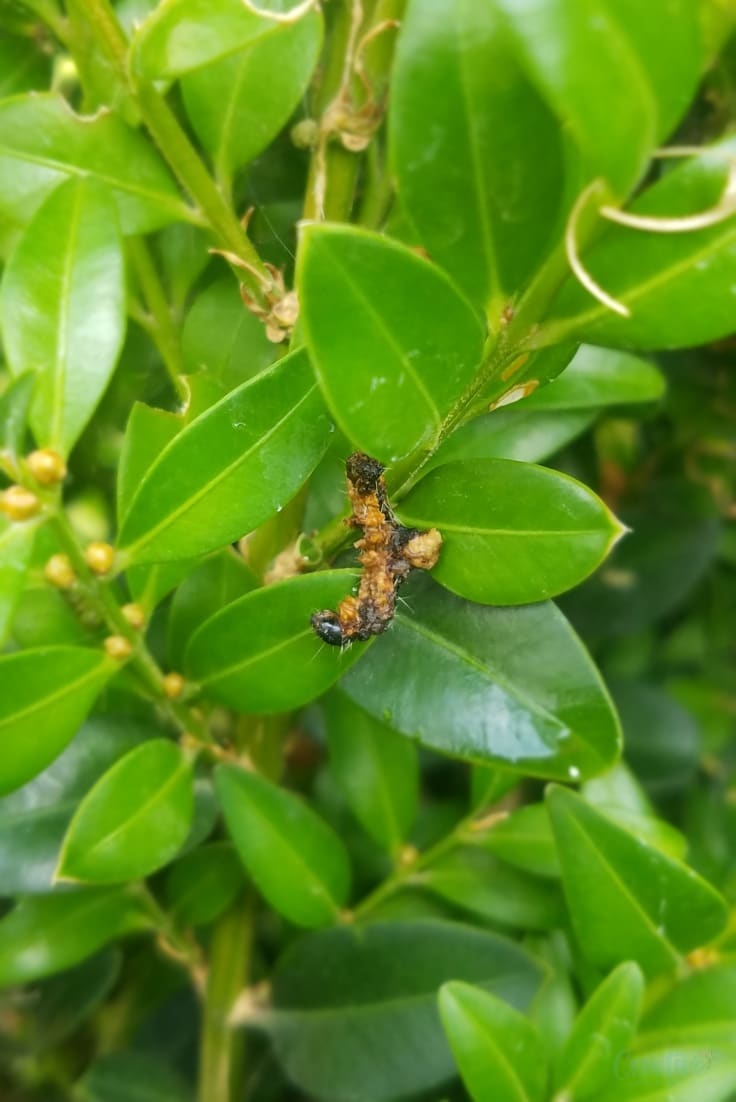
But how wrong I was! I came back from vacation to find my trees badly damaged by these insects. I had to start over but got smarter by identifying the problem. The soapy solution worked, but I didn’t apply it thoroughly—many eggs and pupae survived. The pupae were protected by strong webbing, which caterpillars use to transform into moths. Here’s a caterpillar starting to weave its web.
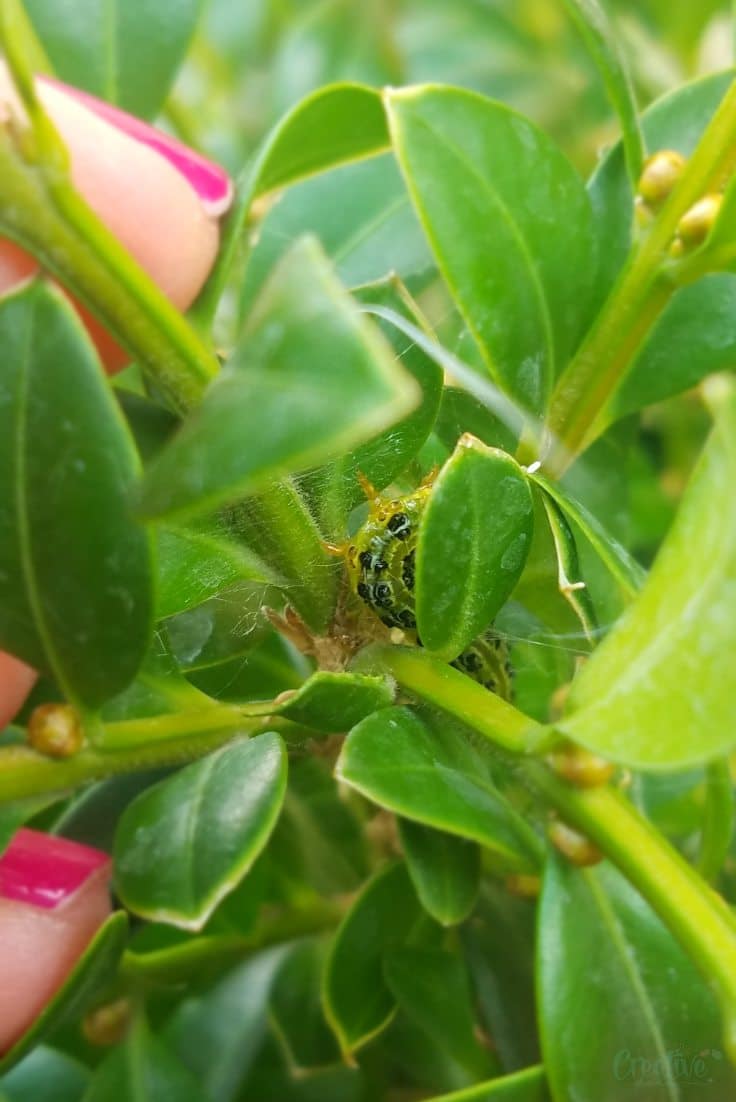
And in this photo, you can (barely) see the eggs where the arrow points. I’m sorry, I forgot to take photos of the eggs. They’re green and gathered in small bunches.
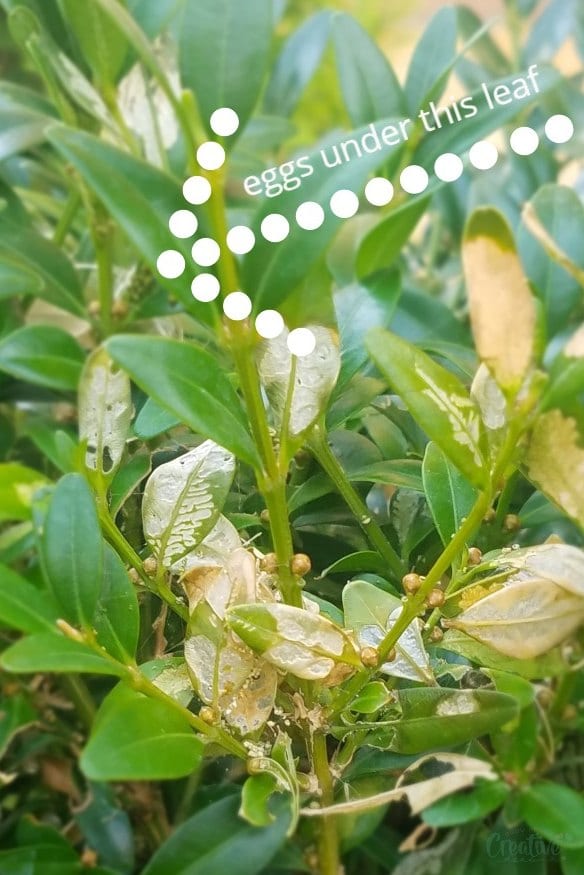
And also…this black spot is caterpillar poop, or at least that’s what I think it is!
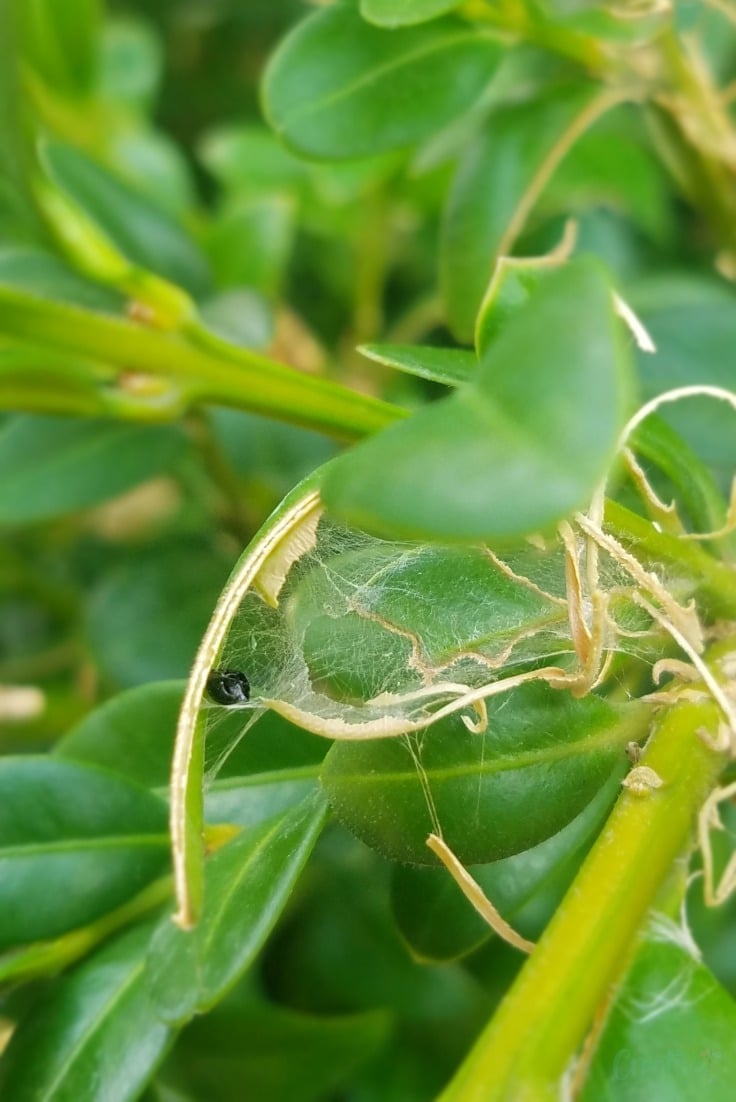
How to make a cheap box tree caterpillar killer
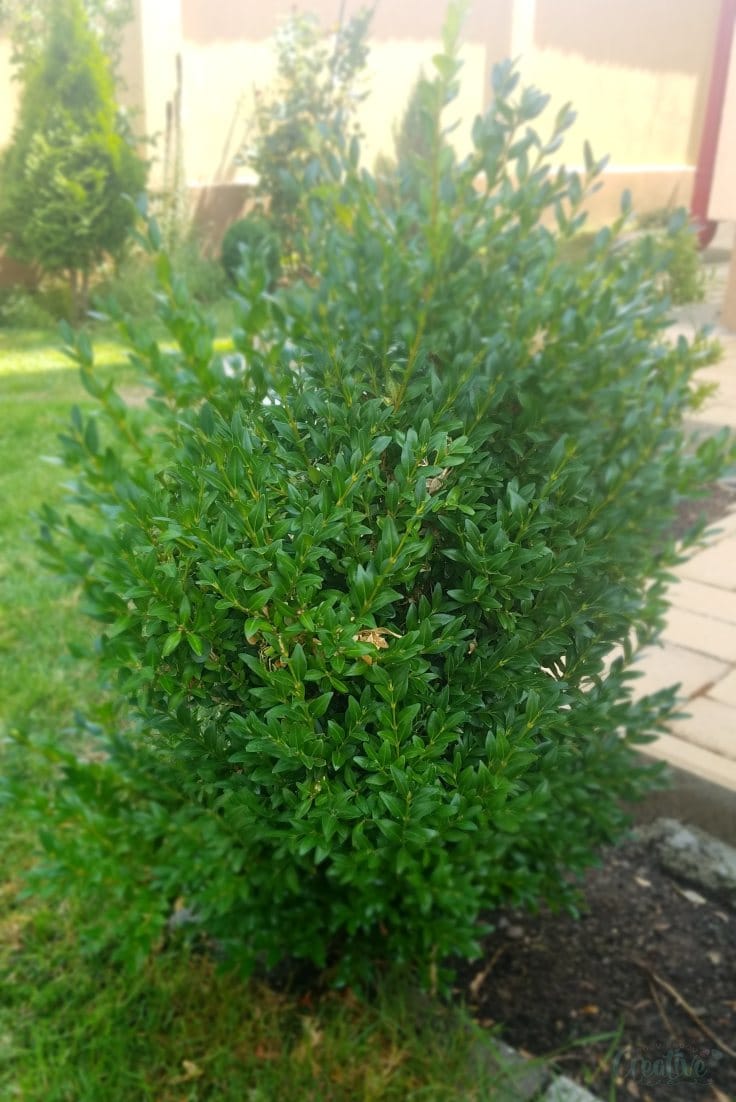
Materials:
- garden gloves
- lemon scented dish soap
- water
- garden sprayer
- garden hose with pressure washer
Directions:
- Try and do all these while the sun is not very strong or in the evening, so the soapy solution won’t evaporate too quickly. Plus caterpillars seem to be more active at night time so they’ll feed on the “fresh” food you just applied to the foliage of your box trees.
Washing the box trees
- When you first spot caterpillars, try and remove as many as you can with your hand. Wear gloves if the thought of touching them scares the bejeezus out of you. You will need to find a way to kill them though, as disgusting as it may sound. I used my garden shoes and took great pleasure into squashing these nasty creatures with it! Pay very close attention and use your hands to reach inside the box tree and at the bottom because the caterpillars are hard to spot as mentioned above. You may need to to a second round once you finish checking your plants.
- Grab the garden hose and with the pressure washer on, give the box trees a really thorough wash, again paying close attention, particularly to the webbing areas where caterpillars, larvae, eggs or cocoons hide. The cocoons tend to be surrounded with lots of dried leaves so the areas are not hard to spot, especially if the plant is severely affected. Wash the plant starting from the top towards the bottom, opening the leaves and pushing the stems out of the way with your hands. I found many eggs laying inside the new shoots.
- The caterpillars are almost impossible to wash with the hose, as they cling to the leaves with a super sticky slime. But you’re aiming for washing and drowning the eggs. The next step will take care of the last few caterpillars you might have missed.
Applying the soapy solution
- Allow the box trees to dry (chances are once you’re done washing, most of them are already dry) then mix dish soap and water (1/2 cup soap to every 33fl.oz water) in a garden sprayer. First add the water to the garden sprayer, then the soap and mix using the sprayer’s nozzle to avoid forming bubbles.
- Give the box trees a thorough wash with the soapy solution. The caterpillars, the pupae and the eggs you may have missed during the washing process, will dry out pretty soon. But if you have a serious infestation, chances are even after applying this homemade killer, you missed a caterpillar or two and maybe a few eggs which are to continue their life cycle, turning into moths/caterpillars. That’s why you need to continue the fight so…
- Repeat the steps above in two days.
Preventing infestation
- After that, apply the soapy solution once a week and keep a close eye on your box trees to spot any new moths or caterpillars. If you do, depending on the severity, you may need to either increase soapy spraying or do a deep clean as highlighted above. Chances are after a couple of deep cleaning sessions, you got rid of all these nasty insects and their eggs and you only need to apply this box tree caterpillar killer as prevention.
Frequently asked questions
What is the box tree caterpillar?
The box tree caterpillars also known as box caterpillars, buxus caterpillars or box tree caterpillars are the larvae of a moth that feeds exclusively on boxwoods. I haven’t had issues with other plants nearby (I have some euonymus right next to my box trees), they seem to favor this particular plant.
They feed ferociously, mostly on the leaves, in most cases causing severe damage to foliage and create a hard webbing while they feed, spreading this webbing over other eggs, making it difficult to reach all the eggs with insecticides. They eat only the soft parts of the leaves, leaving the leaf veins untouched. This is how you can best recognize the presence of this terrible pest into your box trees.
Without the foliage the box tree struggles to survive as the leaves contain most of the chlorophyll, a green pigment in leaves and stems that is light absorbing, helping the box trees get their energy from the sun. Without its beautiful foliage, the box tree might seem like it’s dead but they have the ability to restore pretty quickly, so resist the urge to throw them away if box caterpillar has caused severe damage to your box trees.
In some cases, once all the foliage is consumed, the box caterpillars start feeding on the stems too and this is what causes the buxus to die if you’re not applying a box tree caterpillar killer.
What is the box moth caterpillar?
Box moth and box caterpillars are basically the same insect, on a different life cycle which has four stages. The moth is white in color with white wings, or white with brown edges and sometimes white/clear. It starts laying eggs on the leaves of the box tree, then the eggs hatch into larvae in about 3 weeks and the larvae quickly grow to become caterpillars. These reach maturity very quickly and transform into pupae (cocoons), where they develop into moths. And then the cycle starts again.
The box tree moth is native to Asia and have been brought to Europe around 2000, it then spread to New Zealand in 2012 and US 2011. They’re now a concerning problem worldwide, reoccurring a few times throughout the growing season and in successive years.
They seem hard to combat because the insecticides have a hard time penetrating through the webbing and also because the moth lays an overwhelming amount of eggs. Both the eggs and the caterpillars are hard to spot as their colors are pretty similar to the foliage, green/yellow for eggs (just like the foliage) and green with yellow and brown stripes for caterpillars (which resembles the stems). But there are solutions, even though they require patience and persevering.
Where does the box tree caterpillar come from?
The box tree caterpillar is native to south East Asia. However, it has spread to many other regions including Europe and North America due to the global trade of plants and plant products. It was first reported in the UK in 2007 and has since become a widespread pest in many parts of Europe. In the United States, it was first reported in Connecticut in 2018 and has since been found in several other states.
Box tree caterpillar treatment
If this terrible insect has invaded your garden, you have three options: you can either apply an insecticide, take the non toxic way as I did or consider an alternative to box tree like Berberis thunbergii atropurpurea or Ilex crenata (I have both in my garden and have been more than pleased with how great they look and how easy they are to care for!)
When you’re battling an extensive infestation, applying an insecticide might be your first option. But bare in mind applying them does not ensures complete success and you may need to reapply the insecticide consistently, heavily loading your garden with unnecessary chemicals. Thorough spray coverage is required in all cases and forceful spraying is needed to penetrate the webbing, in many situations, this forceful spraying being ineffective and hand removal might be required. And there is always the risk of killing other useful, pollinating insects in your garden.
For these reasons only you might wanna consider using my homemade box tree caterpillar killer. It’s basically dish soap and water so it’s super affordable, takes minutes to make, it’s non toxic and highly effective if applied thoroughly. If you decide to take this route please follow the tutorial below where I show you how I managed to combat the caterpillars in my box trees effectively. It does take a bit of work but it’s worth it!
Can you set a trap for box caterpillars?
I don’t think you can since they turn into moths and fly from one tree to another, but you can definitely try to physically remove them from your box trees. This can be done by handpicking them off the leaves or using a small vacuum cleaner to gently suck them up.
Another option is to introduce natural predators of box caterpillars into your garden. These include birds, parasitic wasps, and praying mantises. You can attract these beneficial insects by planting flowers that they are attracted to and providing shelter for them.
Want more gardening tips?
- How to prepare soil for grass seed
- Vinegar weed killer solution
- Tips for strawberry plant care
- How to care for raspberry bushes
- Gardening tips for harvesting basil
I hope I managed to help you with this humble solution and if I did, I’d love to know it so please leave a comment below and don’t forget to rate this tutorial. Thanks!
Box tree caterpillar killer
Materials
- lemon scented dish soap
- water
Tools
- garden gloves
- garden sprayer
- garden hose with pressure washer
Instructions
- Try and do all these while the sun is not very strong or in the evening, so the soapy solution won't evaporate too quickly. Plus caterpillars seem to be more active at night time so they'll feed on the "fresh" food you just applied to the foliage of your box trees.
- Washing the box trees
- When you first spot caterpillars, try and remove as many as you can with your hand. Wear gloves if the thought of touching them scares the bejeezus out of you. You will need to find a way to kill them though, as disgusting as it may sound. I used my garden shoes and took great pleasure into squashing these nasty creatures with it! Pay very close attention and use your hands to reach inside the box tree and at the bottom because the caterpillars are hard to spot as mentioned above. You may need to to a second round once you finish checking your plants.
- Grab the garden hose and with the pressure washer on, give the box trees a really thorough wash, again paying close attention, particularly to the webbing areas where caterpillars, larvae, eggs or cocoons hide. The cocoons tend to be surrounded with lots of dried leaves so the areas are not hard to spot, especially if the plant is severely affected. Wash the plant starting from the top towards the bottom, opening the leaves and pushing the stems out of the way with your hands. I found many eggs laying inside the new shoots.
- The caterpillars are almost impossible to wash with the hose, as they cling to the leaves with a super sticky slime. But you're aiming for washing and drowning the eggs. The next step will take care of the last few caterpillars you might have missed.
- Applying the soapy solution
- Allow the box trees to dry (chances are once you're done washing, most of them are already dry) then mix dish soap and water (1/2 cup soap to every 33fl.oz water) in a garden sprayer. First add the water to the garden sprayer, then the soap and mix using the sprayer's nozzle to avoid forming bubbles.
- Give the box trees a thorough wash with the soapy solution. The caterpillars, the pupae and the eggs you may have missed during the washing process, will dry out pretty soon. But if you have a serious infestation, chances are even after applying this homemade killer, you missed a caterpillar or two and maybe a few eggs which are to continue their life cycle, turning into moths/caterpillars. That's why you need to continue the fight so...
- Repeat the steps above in two days.
- Preventing infestation
- After that, apply the soapy solution once a week and keep a close eye on your box trees to spot any new moths or caterpillars. If you do, depending on the severity, you may need to either increase soapy spraying or do a deep clean as highlighted above. Chances are after a couple of deep cleaning sessions, you got rid of all these nasty insects and their eggs and you only need to apply this box tree caterpillar killer as prevention.
Article may contain Amazon & affiliate links. As an Amazon Associate I earn from qualifying purchases at no additional cost to you.


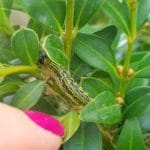
ABOUT PETRO
Hi, I’m Petro, author and founder of Easy Peasy Creative Ideas. Sewist, crafter, avid DIY-er, foodie, photographer, homemaker and mommy to one. I’m an expert at coming up with quick, clever sewing tips, recycling crafts and simple, easy recipes! You can find my ideas featured in reputable publications such as Country Living, Good House Keeping, Yahoo News, WikiHow, Shutterfly, Parade, Brit & Co and more. Thanks for stopping by and hope you’ll stay for a while, get to know me better and come back another time. Stick around for real fun projects! Read more…